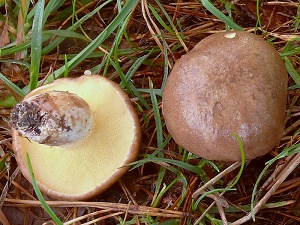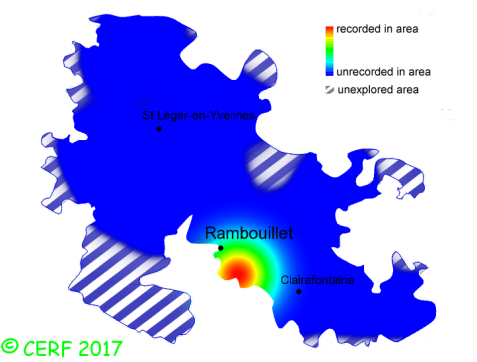| Suillus collinitus (L.:Fr.) Kuntze |
|
|
|
|
|
|
The cap is buff to red or orange-brown, with purple-brown fibrils, fleshy, hemispherical at first then convex and finally almost planar. The cap surface is fibrillose, slimy and sticky in wet weather, matt and downy when dry, entirely peelable. The cap margin is inrolled quite a long time. The stem is full, firm, rather long. It is cylindrical, with a pointy base, non slimy and without ring. Some droplets can be seen sometimes at the top of the stem. It is whitish to yellow at the top (same as the pores) with purple-brown spots, brownish below and lilac-pink at the base (the mycelium is pink at the stem's bottom). The flesh is pale yellow, with vinaceous shades just under the cap surface and in the stem base; its taste is faint, mild; the odour is mushroomy or acidic; The tubes are more or less decurrent, and not easily removed from cap. They are lemon yellow, then olive yellow. The pores are small, angular and irregular. They are lemon yellow then olive yellow. They turn brown when pressed. The spore print is orange-ochre. It grows in coniferous woods, solitary or in small groups, sometimes with Suillus Granulatus, on a rather calcareous soil, with two-needle pines (Scots pines). The fruiting period takes place from June to November.
Chemical tests : The flesh turns coral when in contact with ammonia (NH3). Distinctive features : viscid, fibrillose, tawny to red brown cap; yellow pores, large and angular; decurrent tubes not easily separated from cap; stem without ring, with a pink base; on calcareous soils, mostly with Scots pines Suillus collinitus is rare and confined in the forest of Rambouillet, and is infrequent, more generally speaking . | ||
|
page updated on 14/01/18

